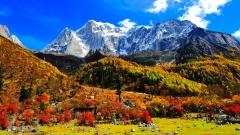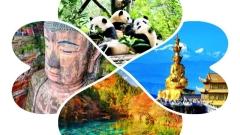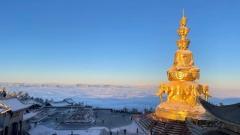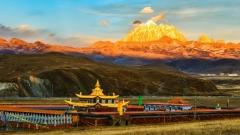Mt. Emei rises like a living, green screen on the edge of the Chengdu Plain — a mountain of dense forests, flowing streams, age-old temples and deep Buddhist tradition. As one of China’s four sacred Buddhist mountains, Mt. Emei is both a spiritual pilgrimage and a natural escape: UNESCO listed it as a combined natural and cultural World Heritage site in 1996. For international travelers it offers a unique mix of accessible trekking, spectacular viewpoints, rich temple architecture, vegetarian temple cuisine and an unforgettable sunrise experience from the Golden Summit (3079.3 m / 10,103 ft).
About Mt. Emei: Nature, Religion and Landscape
Mt. Emei combines towering ancient trees, cool waterfalls, and countless Buddhist temples that climb the mountain’s slopes. For centuries it has attracted pilgrims who come to pay respect to Samantabhadra Bodhisattva — the mountain’s spiritual patron — and to walk the stone stairways that connect monastery complexes and remote hermitages. The mountain’s microclimates and dense forest cover produce clouds of mist, seas of cloud, dramatic sunrise scenes and a strong seasonal variety: cherry and azalea blooms in spring, cool refuge in summer, vivid foliage in autumn and serene snowscapes in winter.
The mountain’s main scenic regions — Baoguo Temple, Wannian Temple, Qingyin Pavilion and the Golden Summit — each have distinct character. Baoguo marks the earthly gateway, Qingyin and Wannian are permeated by classical Buddhist architecture and ritual, and the Golden Summit crowns the landscape with panoramic views and sacred halls.
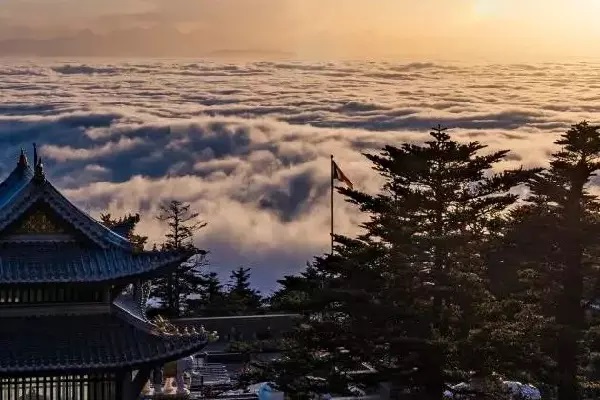
Mount Emei
Mt. Emei Highlights: The Temples, Peaks and Natural Wonders You Can’t Miss
Baoguo Temple: The Gateway to the Mountain
Baoguo Temple sits at the foot of Mt. Emei and functions as the main starting point for many visitors. Built and rebuilt across dynastic eras, it is the administrative and ceremonial center of the Emeishan Buddhist community. The approach to Baoguo is lined with old trees, red walls and a sense of solemnity. From here you can take buses into the scenic zone, begin a walking route or catch a cable car to higher elevations.
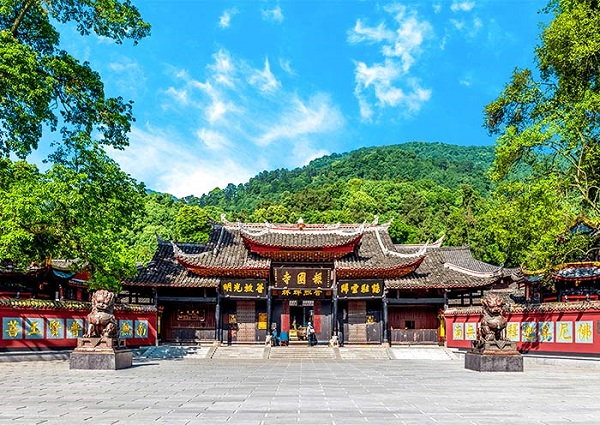
Baoguo Temple
Qingyin Pavilion: Tranquil Rivers and Classical Scenery
Qingyin Pavilion is one of the mountain’s celebrated sites and part of the classic route recommended for hikers. The pavilion area is famous for the “Shuangqiao Qingyin” — two stone bridges that cross clear streams — and for its harmonious blend of architecture and nature. Many hikes begin near Qingyin Pavilion, making it an ideal place to warm up into mountain walking.
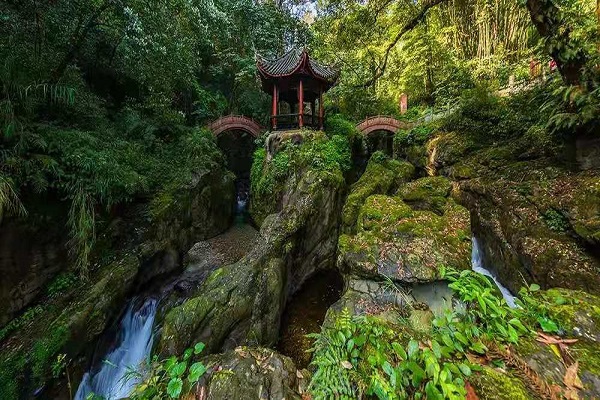
Qingyin Pavilion
Wannian Temple: Ancient Treasures and Architectural Wonder
Wannian Temple is steeped in history. The temple’s Beamless Brick Hall and a 7.4-meter-tall bronze statue of Samantabhadra riding an elephant are particularly notable. The statue is both enormous and artistically important, and the temple complex offers a quiet immersion in time-honored Buddhist ritual and architecture. Wannian’s location amid the forested slopes lends it an atmosphere of seriousness and introspection.
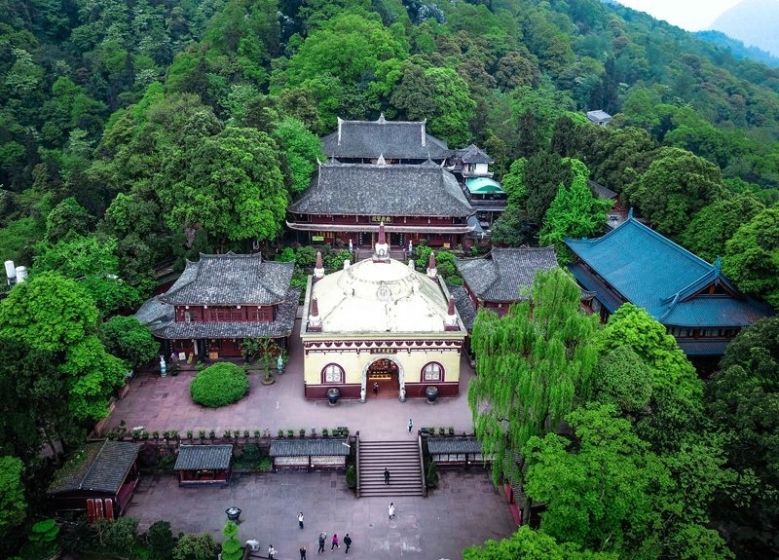
Wannian Temple
Golden Summit: Panoramas, Sunrise and Spiritual Spectacles
The Golden Summit is the crown of Mt. Emei — literally and spiritually. The gilded roof of Samantabhadra Hall gives the summit its name. From the peak you can view four famous natural spectacles: the sea of clouds, sunrise, Buddha rays (crepuscular rays radiating from the rising sun), and the so-called “saint lamps.” The Golden Summit’s altitude (3079.3 m) means cool air, crisp views and often dramatic weather; early mornings reveal why so many visitors rise before dawn to watch the sun climb above the clouds.
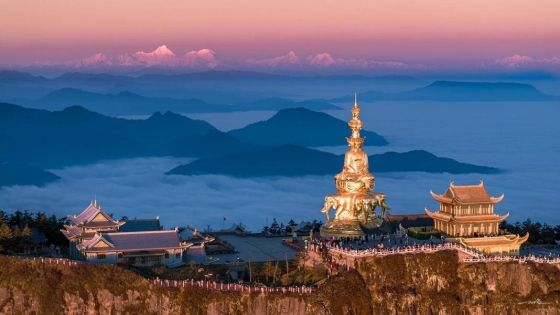
Mount Emei Golden Summit
Mt. Emei Travel Routes: How to Plan Your Walks and Cable Car Rides
Mt. Emei 1 Day Route: High-Impact, Time-Savvy Option
This itinerary is for travelers short on time who still want to experience the mountain’s highlights and the Golden Summit sunrise with minimal hiking effort.
- Start: Emeishan Station → scenic area shuttle bus to Leidongping.
- Cableway: Take the cable car from Leidongping to Golden Summit.
- Sunrise Option: If arriving late afternoon, stay at a summit hotel or guesthouse; otherwise plan to spend a night near the summit for early sunrise access.
- Descent: After sunrise and morning exploration, take the cable car back to Leidongping and return by shuttle bus to the station.
Total active time: about 6–8 hours (depending on queues and how long you stay at the summit). This is the most energy-efficient way to “do” Mt. Emei in a single day.
Mt. Emei 2-Day Route: Cultural Trekking and Full Experience
This two-day plan is the best compromise between exertion and authentic experience, ideal for hikers who want to walk a large portion of the mountain and enjoy temples along the way.
Day 1 (Hike from Qingyin Pavilion up):
- Scenic bus to Qingyin Pavilion, then begin hiking.
- Route: Qingyin Pavilion → Bailong Cave → Wannian Temple → Huayan Peak → Jiulinggang → Xixiangchi → Leidongping → cableway → Golden Summit.
- Overnight: Stay near Golden Summit to catch sunrise and savor evening temple ambiance.
Day 2 (Summit sunrise and descent):
- Watch the sunrise at Golden Summit → descend to Wanfo Peak → return to Golden Summit → cableway down → scenic bus to Emeishan Station.
- Optional afternoon visit: Leshan Giant Buddha or Baoguo Temple.
Total walking time day 1: roughly 7–9 hours depending on pace. Day 2: 3–5 hours.
Mt. Emei 2-Day Route: The Long Hike
For fit hikers who prefer a deeper trekking experience and more temple visits:
Day 1 (Long trek from Baoguo Temple):
- Start at Baoguo Temple → Fuhu Temple → Leiyin Temple → Chunyang Hall → Shenshui Pavilion → Guangfu Temple → Qingyin Pavilion → Hongchunping → Ninety-nine Turns → Xianfeng Temple → Jiulinggang → Xixiangchi → Leidongping cableway → Golden Summit.
- Overnight: Golden Summit or nearby.
Day 2 (Sunrise and descent via Wannian):
- Sunrise at Golden Summit → Wanfo Peak → return to Golden Summit → cableway → Leidongping → scenic bus → Wannian Temple → Bailong Cave → exit at Qingyin Pavilion.
- This is a full itinerary requiring good fitness; total hiking may exceed 10 hours on the first day.
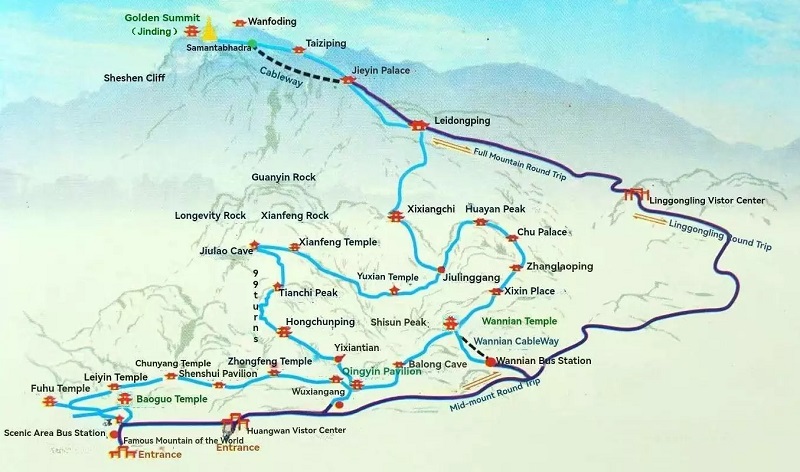
Tourist map of Mount Emei
Mt. Emei Hiking Trail Details and What to Expect on the Path
Stone Steps and Mountain Paths
The mountain is threaded with stone steps that can be steep and numerous. Expect long stair sections interspersed with flat boardwalk stretches and occasional wooden or stone bridges. Trails are well-marked but can be physically taxing — allow time for regular rests and to enjoy temple stops.
Wildlife and Monkeys: Viewing Etiquette
Emei is home to a population of macaques that are accustomed to people. They are curious and bold; do not feed them, keep a safe distance, and secure any food or loose items. Feeding monkeys encourages aggressive behavior and is often prohibited; treating wildlife with respect protects both you and the animals.
Vegetarian Temples and Food Along the Way
Mt. Emei is famed for temple vegetarian cuisine. Many temples run vegetarian eateries that serve simple, nourishing meals — steamed vegetables, rice, tofu-based dishes and local specialties. Sampling temple cuisine is a cultural experience; be prepared for plain but wholesome food and longer waits during peak pilgrimage times.
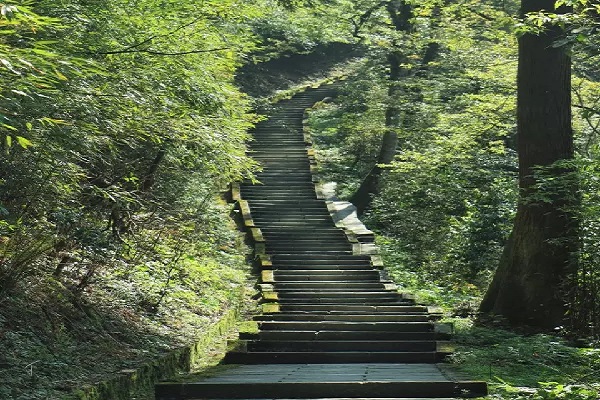
Hiking Trail of Mount Emei
Best Time to Visit Mt. Emei: Season-by-Season Advice
Spring (March to May)
Spring warms the mountain: flowers bloom, streams swell and trails become lively. This is a great time for lower crowds than peak autumn and pleasant hiking temperatures.
Summer (June to August)
Summer is the classic “escape the heat” season for many domestic visitors. Expect cooler mountain temperatures, frequent mist and occasional rain. Waterfalls are full and the forest turns lush green. Bring waterproof gear.
Autumn (September to November) — Peak Choice
Autumn is widely regarded as the best time to visit. Clear skies, crisp air and colorful leaves create extraordinary scenery, especially at mid-to-late October. Expect heavier crowds during national holidays; plan ahead.
Winter (December to February)
Winter offers a tranquil snow-covered Mt. Emei. Some trails or temple amenities may be limited, but the pristine white landscapes and ice-frosted trees are striking. Dress warmly and confirm cableway operations in advance.
How to Get to Mt. Emei: Airports, Trains and Buses
By Plane
The nearest major airports are Chengdu Shuangliu International Airport (CTU) and Chengdu Tianfu Airport (TFU). From either airport you can take high-speed rail to Emeishan Railway Station (fast trains take roughly 1–2 hours), then a short shuttle or taxi to the scenic area.
By Train
Emeishan Railway Station is conveniently close to the scenic zone (about 5 km). High-speed trains from Chengdu East Station take roughly 1 hour and 20 minutes. Trains are frequent; book ahead during holiday seasons.
By Bus
Direct tourist buses run from Chengdu Xinnanmen Bus Station to Mount Emei Jiuzhu Passenger Center (about 2–3 hours; roughly 143 km), and local buses connect Leshan with Baoguo and scenic area gates. Buses are economical and plentiful but can be slower than rail.
Local Transfers and Scenic Buses
From the railway station or bus center, frequent shuttle buses or local taxis provide the final leg to Baoguo Temple, Qingyin Pavilion or the scenic area entrances. Once inside the scenic zone, internal shuttle buses and cableways connect major nodes like Leidongping, Wannian, and the Golden Summit.
Mt. Emei Practical Tips: Clothing, Gear, Health and Safety
Temperature Differences and What to Pack
Expect a temperature difference of about 14°C (≈25°F) between the foot and summit on typical days. Layers are essential: base layer, mid-layer fleece, waterproof shell, and a warm hat for summit mornings. Comfortable walking shoes with good grip are a must; hiking poles help on steep stair sections.
Altitude and Physical Preparedness
At 3079.3 meters the Golden Summit is high enough for some people to feel breathless. Most visitors experience only mild symptoms if they pace themselves, stay hydrated and avoid heavy exertion on the first day. If you have heart or lung conditions, consult a medical professional before travel.
Monkeys and Wildlife Safety
Never feed wildlife. Keep food sealed, avoid eye contact with aggressive monkeys, and step back slowly if a monkey approaches. Staff may intervene when animals get too bold; always follow instruction signage.
Cableway Etiquette and Safety
Cable cars reduce hiking time dramatically but can have lines. Follow staff directions for boarding and disembarking, secure loose items and remain seated or hold handrails. Check operating hours; weather can close cableways temporarily.
Emergency and Medical Advice
Carry a small first-aid kit, any personal medications, and basic altitude sickness tablets if recommended by a doctor. Note local emergency numbers and have your accommodation’s contact information handy. Travel insurance that covers mountain evacuation is advised for peace of mind.
Accessibility
The mountain offers shuttle buses, cableways and boardwalks making many highlights reachable for visitors with limited mobility; however, some viewpoints and historic paths include stairs and uneven stone. Contact park authorities or your tour operator if wheelchair accessibility is essential.
Families and Older Travelers
Families can enjoy short hikes, cable car rides and temple visits. Older travelers should consider the one-day cable-car option unless they are physically fit for stair climbs. Bring snacks, water and clothing appropriate for changing mountain weather.
Photography Tips: How to Capture Mt. Emei’s Best Moments
- Golden Hour: Sunrise (from Golden Summit) and sunset produce magical light and cloud seas.
- Sea of Clouds: After a cold night, valleys often fill with a rolling cloud layer — look for patterns and silhouettes.
- Temple Details: Close-up shots of roof tiles, carved beams and bronze statues reveal incredible craftsmanship.
- Monochrome Mornings: Misty mornings simplify the palette and create moody images — use higher ISO and slower shutter speeds if light is low.
- Composition: Use temple roofs, staircases and winding paths as leading lines into your frame. Respect temple rules about photography inside halls and shrines.
Mt. Emei Frequently Asked Questions (FAQ)
Q: How many days do I need to properly see Mt. Emei?
A: One day with cable cars will show you key highlights and sunrise at the Golden Summit (if timed well). Two days is ideal for a balanced mix of hiking, temples and culture. For a relaxed immersive experience consider two full days plus nearby Leshan.
Q: Are there places to stay on or near the Golden Summit?
A: Yes — there are simple guesthouses and small hotels near the summit as well as accommodations at Leidongping and in Emeishan town. Book in advance during peak seasons if you plan to stay on the summit for sunrise.
Q: Can I combine Mt. Emei with Leshan Giant Buddha?
A: Absolutely — Leshan Giant Buddha is a popular half-day or day visit combined with Mt. Emei for a culturally rich trip. It’s common to schedule a temple visit or the Leshan site the afternoon after descending from the mountain.
Packing Checklist for Mt. Emei Tour
- Sturdy hiking shoes or boots
- Lightweight layers + warm mid-layer
- Waterproof shell / rain jacket
- Hat, gloves (for summit mornings)
- Reusable water bottle and light snacks
- Small first-aid kit and personal meds
- Camera, spare batteries / memory cards
- Walking pole (recommended)
- Sunscreen and sunglasses
- Travel insurance info and emergency contacts
Why Mt. Emei Belongs on Every Traveler’s List
Mt. Emei is a uniquely layered travel destination: spiritual depth and pilgrimage, remarkable temple architecture, accessible but rewarding hiking, and dramatic natural spectacles from sea-of-clouds sunrises to quiet winter snowscapes. For international visitors, planning helps — whether you opt for the time-saving cableway sunrise, a two-day trek that visits Wannian and Qingyin Pavilion, or a longer cultural exploration that combines Leshan and the mountain’s quieter hermitages.
If you’d like tailored support, China Dragon Travel specializes in crafting bespoke Mt. Emei itineraries for international travelers: private transfers from Chengdu airports and train stations, summit hotel reservations, English-speaking guides, flexible pacing to account for altitude and comfort, and combined Leshan + Emei packages. Contact China Dragon Travel to arrange a worry-free trip so you can focus on the temples, the views and the quiet moments that make Mt. Emei unforgettable.
Mt. Emei Suggested Itineraries
7-Day 6-Night Chengdu, Jiuzhaigou & Mount Emei Tour $ From 610/Pax
Day 1: Chengdu Airport/Train Station Pick-up – Hotel Check-in – Free Time in Downtown Chengdu
Day 2: Chengdu – Chengdu Research Base of Giant Panda Breeding – High-Speed Train to Jiuzhaigou – Hotel Check-in
Day 3: Full-Day Tour of Jiuzhaigou Scenic Area
Day 4: Jiuzhaigou – Huanglong Scenic Area – High-Speed Train to Chengdu – Hotel Check-in
Day 5: Chengdu – Huanglongxi Ancient Town – Leshan Giant Buddha – Mount Emei Hotel Check-in
Day 6: Mount Emei Full-Day Tour – Evening Return to Chengdu
Day 7: Airport/Train Station Transfer – End of Tour
- Brief itinerary:Chengdu Research Base of Giant Panda Breeding, Jiuzhaigou, Huanglong Scenic Area, Leshan Giant Buddha, Mount Emei
- ⇒ Click here to see detailed Itinerary




